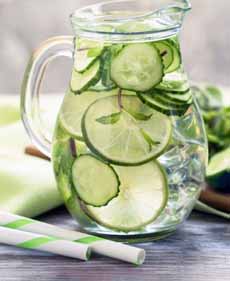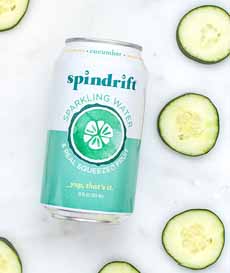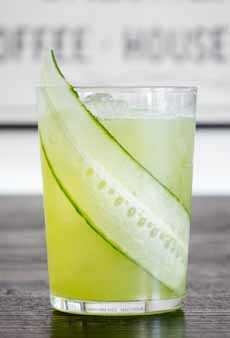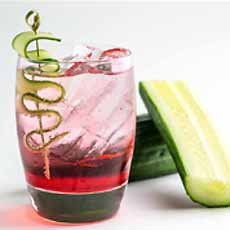
[1] Add cucumber slices to a pitcher of water. Lemon, lime and/or mint sprigs make it even more delicious (photo courtesy HealthiGuide).

[2] DRY Sparkling, a cucumber soda low in sugar, is one of our favorites straight or as a mixer (photo courtesy DRY Sparkling).

[3] Spindrift’s Sparkling Water is flavored with real squeezed cucumber, no sweetness added (photo courtesy Spindrift).

[4] This garnish is at home in a cocktail or a glass of club soda (photo courtesy Dante | NYC).

[5] Make a curly cucumber cocktail garnish on a cocktail pick (photo courtesy AnQi | Costa Mesa) .
|
|
June 13th is National Cucumber Day. Cucumbers are so refreshing, they’re a natural for drinks.
DRINKS FOR EVERYONE!
Cucumber Cocktails
We like to sip cucumber vodka straight or on the rocks. Brands like Effen, Ketel One, Prairie, Svedka, Rain and others sell it. Some are straight cucumber, some add lime.
You can make these cocktails with plain or cucumber vodka. Or, infuse your own cucumber vodka at home.
Cucumber Mary Cocktail
Cucumber Tequila Cocktail
Gin Lemonade With Cucumber
Non-Alcoholic Cucumber Drinks
Homemade cucumber water: infuse sliced cucumbers in a pitcher of water, with optional lemon/lime and mint (photo #1)
Cucumber DRY Sparkling
Cucumber Hint Water
Cucumber Spindrift Sparkling Water
Cucumber Appetizers
If you’d like a cucumber snack with your cucumber drink, try:
Stuffed Cucumber Bites
Cucumber-Prosciutto Roulades
CUCUMBER TYPES
Growers define cucumbers in five categories: slicing, pickling, burpless, space savers and specialty.
Slicing cucumbers include the typical supermarket variety: long and straight with thin, non-bitter skins and seeds. They are bred for slicing and eating. The skin of younger, unwaxed cucumbers is tender enough to be eaten. As the fruit* grows, the skins thicken and more seeds develop. If left on the vine too long, the flesh may become bitter.
Pickling cucumbers are shorter and stouter. They are bred to have drier flesh, which allows them to soak up more of the pickling brine.
Burpless cucumbers are slicing cucumbers that have been bred to produce less of the bitter chemical that releases gas in the stomach. They were developed because enough Americans had this sensitivity.
Space saver cucumbers, also called container cucumbers, are bred to create compact vines that fit into small gardens and deck planters.
Specialty cucumbers are heirloom cucumbers that have less developed disease resistance than modern hybrids (that’s why fewer growers plant them), but are appreciated for their different flavors, shapes and/or colors. There’s more in the next section.
SPECIALTY CUCUMBERS
You can eat, drink or garnish with any supermarket cucumber, but why not have fun and look for specialty varieties?
You know what conventional cucumbers look like. Check farmers markets for specialty varieties like these:
Armenian cucumbers are heavily ribbed—decorative and ornamental—and taste like a melon without the sweetness. They are particularly interesting for salads and garnishes.
Crystal Apple cucumbers, heirlooms from New Zealand, have pale green, roundish fruits resembling Granny Smith apples.
Lemon cucumbers are yellow and shaped like lemons.
Suyo Long is a traditional variety from China that delivers burpless, sweet ribbed fruits that can be used for slicing or pickling.
Palace King is a hybrid that has ripples of yellow on emerald green skins.
White cucumbers are ivory in color. They are a mutation that occurred in the early 1890s in western New York State, and the seeds were sent to Burpee.
Your homework: Go to the farmers market and look for specialty cucumbers. If you have a garden, check out the options and plan to plant at least one variety next year.
* CUCUMBER TRIVIA
Cucumbers are fruits. They are members of the same botanical genus as cantaloupe, honeydew, Persian melon and other melons.
A giveaway: Fruits carry their seeds on the inside.
The exception is the strawberry: Technically, the strawberry is an aggregate accessory fruit, meaning that the fleshy part is derived not from the plant’s ovaries but from the receptacle that holds the ovaries.
The tiny “seeds” (called achenes) on the outside of the berry are actually teeny ovaries of the flower, with a teenier seed inside it.
|







